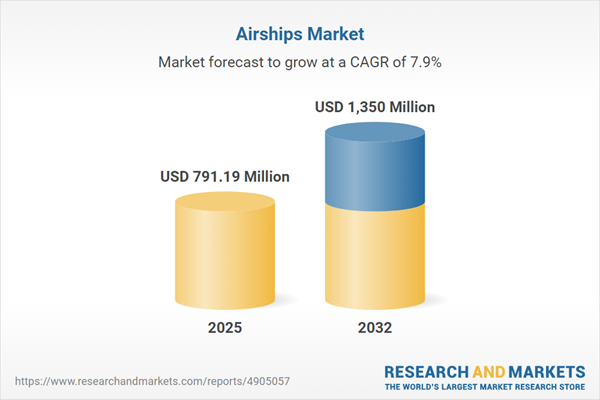Speak directly to the analyst to clarify any post sales queries you may have.
The global airships market is evolving as commercial and government leaders seek efficient solutions for logistics and operations that satisfy sustainability goals and leverage advanced technology. Airships are gaining renewed attention as versatile assets across public and private sectors worldwide.
Market Snapshot: Growth and Trends in the Global Airships Market
The global airships market is projected to grow from USD 733.88 million in 2024 to USD 791.19 million in 2025, at a compound annual growth rate (CAGR) of 7.94%. By 2032, the market is anticipated to reach USD 1.35 billion. This growth reflects advances in lightweight materials, propulsion systems, and expanding applications. Market activities now encompass logistics, surveillance, research, and operational roles across both commercial and governmental organizations. Evolving regulatory standards and an increased focus on sustainable aviation are driving new market adoption, while expansion into emerging economies boosts prospects for airship solutions as reliable transport and research platforms.
Scope & Segmentation: Insights for Strategic Procurement
This analysis supports senior decision-makers with detailed and actionable segmentation to guide procurement and logistic strategies within the airships market. Understanding the following dimensions is critical for aligning organizational goals with contemporary sector trends:
- Platform Types: Non-rigid airships are favored for advertising and expedited transport; rigid variants support heavier loads and large-scale missions; semi-rigid designs meet mid-range use cases.
- Propulsion Types: Fuel, electric, and hybrid propulsion options address emission targets and diverse mission profiles.
- Product Types: Manned airships cater to tourism and logistics; unmanned models enhance surveillance, monitoring, and operations in high-risk environments.
- Payload Capacity: Configurations from below 500 kg to above 1,000 kg provide scalability for tactical to specialized deployments.
- Operating Altitudes: Low-altitude models serve urban routes; high-altitude options support communications and research in challenging regions.
- Applications: Solutions address advertising, defense, logistics, research, reconnaissance, and tourism for both public and commercial stakeholders.
- Customer Types: Commercial buyers seek speed and flexibility; government agencies focus on regulatory alignment; defense sectors need resilience and security.
- Geographical Regions: Adoption is shaped by local regulations, supply chain context, and technological readiness in the Americas, Europe, Middle East, Africa, and Asia-Pacific.
- Key Companies Analyzed: Lockheed Martin Corporation, Hybrid Air Vehicles Limited, Worldwide Aeros Corp., Flying Whales SAS, Zero 2 Infinity S.L., Varialift Systems LLC, ZLT Zeppelin Luftschifftechnik GmbH & Co. KG, Lindstrand Industries, TCOM L.P., RosAeroSystems.
Key Takeaways: Strategic Considerations for Decision-Makers
- Advancements in materials technology are equipping airship platforms for evolving mission profiles and tighter regulatory standards.
- Electric and hybrid propulsion increase flexibility and support sustainability initiatives as market regulations advance.
- Modular payload systems allow for efficient upgrades, lower initial investment, and smooth integration of mission-specific technology.
- Building partnerships across sectors such as energy and telecommunications supports mission reach and access in underserved areas.
- A streamlined certification process and the rise of unmanned airships are expanding private and public sector project opportunities.
- Choosing tailored technology and applications strengthens supply chains and helps organizations adapt to changing regional dynamics.
Tariff Impact on Airship Industry Supply Chains
Adjustments in U.S. tariffs affecting specialty textiles and aerospace components are introducing new cost and supply challenges for global manufacturers. In response, industry players are diversifying procurement channels, fostering relationships with local and regional suppliers, and implementing risk management practices. These measures help stabilize supply chains and mitigate operational disruptions arising from shifting trade policies and regulatory uncertainty.
Methodology & Data Sources
This report integrates expert interviews, market analysis, peer-reviewed studies, and recent patent reviews for a multi-perspective view. Each data point is independently validated to ensure B2B leaders receive actionable intelligence aligned with sector objectives and regulatory requirements.
Why This Report Matters for Business Leaders
- Comprehensive segmentation and technology coverage empower executives to navigate procurement challenges and enhance operational stability in changing environments.
- Clear benchmarking enables risk identification and supports proactive planning for organizational growth and market positioning.
- Guidance on integrating sustainability and advanced technologies prepares leadership for shifts in regulation and customer expectations.
Conclusion
This report delivers practical segmentation and strategic insight for airship procurement, enabling business leaders to make informed decisions as operational priorities and global markets continue to evolve.
Additional Product Information:
- Purchase of this report includes 1 year online access with quarterly updates.
- This report can be updated on request. Please contact our Customer Experience team using the Ask a Question widget on our website.
Table of Contents
3. Executive Summary
4. Market Overview
7. Cumulative Impact of Artificial Intelligence 2025
Companies Mentioned
The companies profiled in this Airships market report include:- Lockheed Martin Corporation
- Hybrid Air Vehicles Limited
- Worldwide Aeros Corp.
- Flying Whales SAS
- Zero 2 Infinity, S.L.
- Varialift Systems LLC
- ZLT Zeppelin Luftschifftechnik GmbH & Co. KG
- Lindstrand Industries.
- TCOM L.P.
- RosAeroSystems
Table Information
| Report Attribute | Details |
|---|---|
| No. of Pages | 192 |
| Published | October 2025 |
| Forecast Period | 2025 - 2032 |
| Estimated Market Value ( USD | $ 791.19 Million |
| Forecasted Market Value ( USD | $ 1350 Million |
| Compound Annual Growth Rate | 7.9% |
| Regions Covered | Global |
| No. of Companies Mentioned | 11 |









